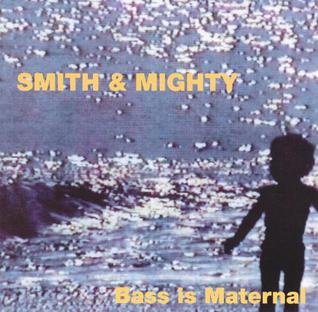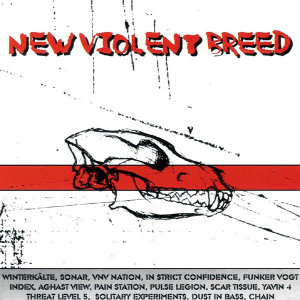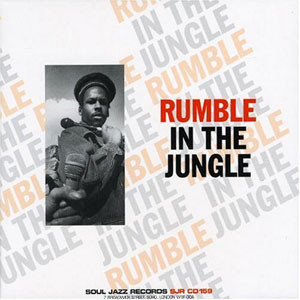Drum and bass is a genre of electronic dance music characterized by fast breakbeats with heavy bass and sub-bass lines, samples, and synthesizers. The genre grew out of the UK's jungle scene in the early 1990s.
Breakbeat hardcore is a music genre of the very early 1990s that spawned from the UK rave scene. It combines four-on-the-floor rhythms with breakbeats usually sampled from hip hop. In addition to the inclusion of breakbeats, the genre also features shuffled drum machine patterns, hoover, and other noises originating from new beat, sounds from acid house and bleep techno, and often upbeat house piano riffs and vocals.
Jungle is a genre of dance music that developed out of the UK rave scene and sound system culture in the 1990s. Emerging from breakbeat hardcore, the style is characterised by rapid breakbeats, heavily syncopated percussive loops, samples, and synthesised effects, combined with the deep basslines, melodies, and vocal samples found in dub, reggae and dancehall, as well as hip hop and funk. Many producers frequently sampled the "Amen break" or other breakbeats from funk and jazz recordings. Jungle was a direct precursor to the drum and bass genre which emerged in the mid-1990s.
Breakcore is a style and microgenre of electronic dance music that emerged from jungle, hardcore, and drum and bass in the mid-to-late 1990s. It is characterized by very complex and intricate breakbeats and a wide palette of sampling sources played at high tempos.
Skam Records is an independent electronic music record label based in Manchester, England, founded by Andy Maddocks around 1990. Skam also runs a smaller sub-label called 33.
Free tekno, also known as tekno, freetekno and hardtek, is the music predominantly played at free parties in Europe. The spelling of the word tekno is made to deliberately differentiate the musical style from that of techno. The music is fast and it can vary between 150 and 185 bpm and is characterised by a pounding repetitive kick drum. Nevertheless, bass drum distortion by clipping is used less often as in the related genre of mainstyle hardcore. Nowadays, some tekno producers also use drum sets that rather sound trancey, since many members of the tekno subculture as well as the psytrance subculture frequently attend the same raves and the two scenes are closely connected.

Kevin Richard Martin, often known under his recording alias The Bug, is a musician, record producer and journalist from England, UK. Martin moved from Weymouth to London around 1990 and is now currently based in mainland Europe. He has been active for over two decades in the genres of dub, jazzcore, industrial hip hop, dancehall, and dubstep.
Drum and bass is an electronic music genre that originated in the UK rave scene having developed from breakbeat hardcore. The genre would go on to become one of the most popular genres of electronic dance music, becoming international and spawning multiple different derivatives and subgenres.

Bass Is Maternal is the debut studio album by Bristolian production duo Smith & Mighty, originally released by More Rockers in 1995. The album was originally recorded in 1989 for ffrr/London Records, who had signed the duo after they had built up underground success in their native city for their innovative Bristol underground scene sound, but the labels deemed the record unsuitable for release. The record explores links between dub music and British rave culture, incorporating styles of rock, reggae and electronic music with an emphasis on dub-style bass. The album title and artwork highlight the perceived association between the exposure of bass and maternity.

Jordana LeSesne, formerly known as 1.8.7, is an American musician and producer from Pittsburgh, Pennsylvania. She now produces and performs as Jordana. She became known in the mid-1990s as a drum and bass producer. Vibe magazine called her "one of the most respected Drum ‘n' Bass producers in the US." In 2015, she was named as one of "20 women who shaped the history of dance music" by Mixmag. She is transgender and came out in 1998.
Appliance were a British experimental post-rock three piece band, who released four albums between 1999 and 2003 on Mute Records.

Cascade is the fifth studio album by English musician Peter Murphy. It was released on 11 April 1995, through Atlantic and Beggars Banquet Records. Produced by Pascal Gabriel, it is Murphy's last album on Beggars Banquet and first album not to feature his backing band, The Hundred Men, which disbanded after Holy Smoke tour.

The Body Lovers and The Body Haters were experimental music projects led by composer Michael Gira between 1998 and 1999 following the breakup of Swans in 1997. Both projects served as an outlet for Gira's loop experimentation within the drone and dark ambient genres and were compared to the compositions comprising Swans' final pre-breakup album Soundtracks for the Blind. The music was built around samples and found sounds, some of which dated as having been recorded as far back as 1980.

Happy 2b Hardcore is a DJ mix album by Canadian DJ Anabolic Frolic. It was released in 1997 on American breakbeat label Moonshine Music and is the first series in Frolic's Happy 2b Hardcore series of DJ mix albums, documenting the emergence of happy hardcore music in the United Kingdom and Europe. The series itself is a spin-off of Moonshine's Speed Limit 140 BPM+ series of fast-tempo dance music compilations. The album was conceived to introduce American audiences to happy hardcore, and contains sixteen of the genre's anthems which carry many of happy hardcore's defining characteristics, such as fast tempo, frantic breakbeats, major key tonality, off-kilter, quirky keyboard effects and "semi-melodies."

Interstate is the fifth album by American post-rock and instrumental rock band Pell Mell, released in 1995. After issuing Flow in 1991, the band members wrote new material separately, sending each other ideas, until more concrete ideas were becoming formed, leading to the band recording Interstate between two studios in 1993 and 1994. Defined by a breezy, wide-open sound, Interstate features sparse, rhythmic guitar riffs, organ playing, drums and thematic instrumentation, in addition to a distinctive compositional style that has been compared to "the dynamics of a good conversation" by one critic. Additionally, the album has been considered a post-rock album and critics have noticed its display of krautrock influences.

Reggae Owes Me Money is the debut album by British duo The Ragga Twins, produced by hardcore duo Shut Up and Dance and released on the latter's record label of the same name. After establishing themselves as dancehall artists from the Unity soundsystem in the 1980s, the Ragga Twins switched direction in the early 1990s, combining into a duo after signing to Shut Up & Dance's label. The production duo stirred the Ragga Twins' change in direction, fusing their previous reggae and dancehall style into the Shut Up & Dance rave dance style.

New Violent Breed is a various artists compilation album released on July 21, 1998 by COP International.

Diva X Machina 2 is a various artists compilation album released on July 14, 1998 by COP International. The compilation peaked at #2 on the CMJ RPM charts.

Infiltrate & Corrupt! is a various artists compilation album released on March 24, 1997, by COP International.

Rumble in the Jungle is a 2007 compilation album released by Soul Jazz Records. It compiles early 1990s ragga jungle tracks.













